
A tooth is surrounded by two types of gum tissue. The gingiva is the part that is around the neck of the tooth and attached to the underlying bone. Immovable and tough, the attached gingiva deflects food as it hits the gum. The second type is called alveolar mucosa, or looser gum below the attached gingiva. This tissue contains muscle and allows movement of the cheeks and lips thanks to its flexibility. The constant contracting of the muscles in the alveolar mucosa pulls on the bottom edge of the attached gingiva. A normally attached gingiva is wide and strong enough to act as a barrier to prevent the gum from being pulled down in a receding fashion.
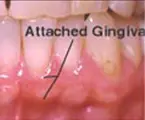
Adequate attached (hard) gum to prevent spontaneous recession. No grafting needed.
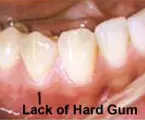
Insufficient attached gum results in recession starting
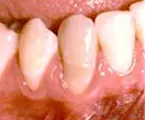
Insufficient attached gum without treament results in continued loss of gum and bone
Those born without sufficient attached gingiva can see their gum slowly continue to recede over time, even though the patient may be very conscientious about their oral health. This is just an anatomic condition, not an infection associated with periodontal disease. However, the bone won’t allow itself to become exposed to the oral cavity and move down with the gum.
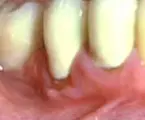
Lack of attached gum with resulting recession
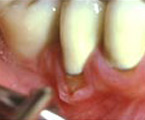
Note gum pulling away when cheek muscle retracted. The bone that previously covered the root has also receded.
Periodontists sometimes associate a lack of attached gingiva with a high frenum attachment, which exaggerates the pull on the gum margin. The frenum is a naturally occurring muscle attachment, typically seen between the front teeth. If pulling is seen on the gum margin or recession, the frenum is surgically released from the gum with a frenectomy. A new band of hard gum is also added to re-establish an adequate amount of attached gingiva.
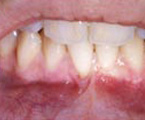
Child with naturally occuring high frenum attachment
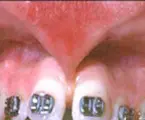
High frenum with lack of attached gum causing muscle pull and tooth separation.
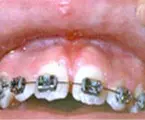
After frenum removal, and addition of adequate attached gingiva.

Recession associated with a lack of attached gingiva. The bone has also receded. Untreated, this may result in tooth loss.

After placement of a gum graft, adequate attached gingiva to prevent further bone/tissue loss.

Recession with no attached gum. Without treatment, the recession will continue. The root is difficult to clean, leading to plaque formation and inflammation.

After placement of new attached gum.
Even normal attached gum can be worn away over time, typically from vigorous brushing. We often see this in those with naturally thin tissues or when the tissues have been stretched during orthodontic care. If there is still adequate attached gum to act as a muscle barrier, the treatment for recession is to prevent any future damage while brushing. An attached gum that’s worn to the point where it can’t resist the constant pull of the mucosa will continue to recede unless a new hard band of gum is placed. Recession can eventually cause tooth loss if unchecked by a professional.
Gingival grafting is the replacement of missing attached gum. The muscle pulling down is surgically resected and repositioned away from the gum margin. A small piece of attached gingiva is then taken from the roof of the mouth and transplanted to the necessary area. A new layer of attached gum is formed and the quick healing process of the roof of the mouth begins to take place. Patients can enjoy the benefits of this procedure with no fear of postoperative pain, which can be managed just fine with over-the-counter pain medication. Patients find the most difficult part to be having to not chew on the area for two weeks.
If you desire to cover up the exposed root surface, a different technique will be used. Keep in mind, however, that root coverage procedures are primarily done for cosmetic reasons or when there is exceptional root sensitivity after recession.

Lack of attached gum with resulting recession

Note gum pulling away when cheek muscle retracted. The bone that previously covered the root has also receded.